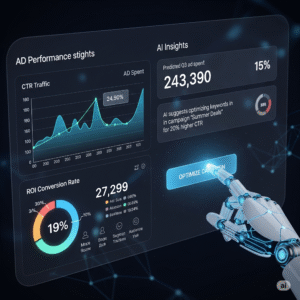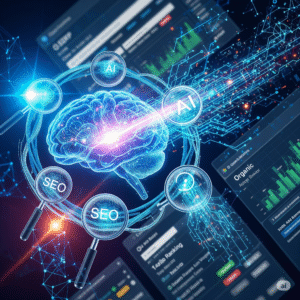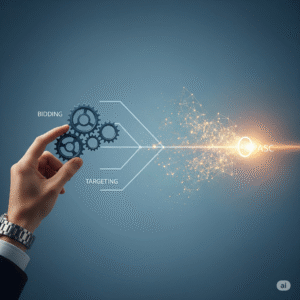The digital marketing world changes constantly. Today, a new player is not just changing the game; it’s rewriting the rulebook entirely. Artificial Intelligence, or AI, is no longer a futuristic concept but a powerful tool that marketers are using to transform their strategies. The question on many minds is simple: Is the investment in AI in Marketing truly worth it, especially for creating hyper-effective personalized campaigns?
The short answer is a resounding “yes.” However, the full story is more complex and far more exciting. At its core, the value of AI in Marketing lies in its ability to process vast amounts of data at a speed and scale that humans cannot. This capability allows marketers to move beyond generic messages and create tailored experiences for every single customer. This shift is not just about being more efficient; it’s about being more human, more relevant, and ultimately, more profitable.
In this comprehensive guide, we will explore the tangible benefits of adopting AI in Marketing, dive into real-world case studies, and provide a clear, step-by-step roadmap for getting started. We will show you exactly how this technology turns data into decisions, and how it makes your marketing efforts smarter, more effective, and more valuable. Whether you are a marketing veteran or just starting out, this guide will provide the insights you need to make an informed decision about your future strategy.
From Data to Decisions: The Core of AI in Marketing
Before we can appreciate the results, we must understand the process. AI in Marketing is, fundamentally, a data-driven engine. Modern marketing generates immense amounts of data from various sources: website analytics, social media interactions, email open rates, customer purchase history, and more. For a human team, sifting through this mountain of information to find patterns and insights is a near-impossible task.
This is where AI excels. Instead of simply collecting data, it analyzes it to find hidden correlations and predictive patterns. It can identify which customers are most likely to churn, which product a shopper might buy next, or the perfect time to send an email. This is not guesswork; it is intelligent, data-based forecasting. Consequently, marketers can make strategic decisions based on evidence, not just intuition. This power of predictive analytics is the bedrock of any successful AI in Marketing strategy.
The ability to predict customer behavior is particularly crucial for developing successful personalized campaigns. Without AI, marketers often rely on broad demographic data or past purchase history, which can be limiting. By contrast, AI can create intricate customer segments based on dozens of different behavioral and psychographic variables, leading to a much deeper and more nuanced understanding of the target audience.
Why You Need Personalized Campaigns (and How AI Helps)
Generic marketing messages are quickly becoming obsolete. In a crowded marketplace, consumers expect brands to understand their individual needs and preferences. When a brand sends a one-size-fits-all email or shows an irrelevant ad, it doesn’t just fail to convert; it erodes trust and makes the customer feel like just another number.
This is why personalization is no longer a luxury but a necessity. By tailoring content, offers, and experiences to the individual, you make your customers feel seen and valued. This is a human-centric approach, and AI in Marketing makes it scalable. AI enables businesses to deliver these personalized experiences at every touchpoint, from the moment a potential customer lands on a website to the post-purchase follow-up. This is the ultimate goal of effective personalized campaigns.
The power of AI for real-time personalization is particularly transformative. Imagine a visitor arrives at your e-commerce site. An AI system can instantly analyze their Browse history and purchase data, then dynamically adjust the homepage to display products they are most likely to be interested in. Similarly, if they have an abandoned cart, an AI-powered email system can send a personalized reminder with a special offer just for them.
Case Study: The Netflix Recommendation Engine
Netflix is a prime example of a company that has built its entire business model on the back of AI in Marketing. While their AI is a large-scale business intelligence tool, its output is pure personalization. Netflix uses AI to analyze a user’s viewing habits, including what they watch, when they watch it, and how long they watch it for. Then, based on this data, the AI generates personalized recommendations, creating a unique homepage for each of its millions of users.
Consequently, this intelligent system keeps subscribers engaged and reduces churn. Netflix’s AI is so effective that it is estimated to save the company over $1 billion per year by preventing subscriber cancellations. This case study demonstrates that a smart AI in Marketing strategy can directly translate into significant revenue and customer loyalty. The personalized recommendations are a form of a personalized campaign, but on a massive, automated scale.
Essential AI Tools for Your Marketing Stack
Getting started with AI in Marketing does not require building a complex system from scratch. Many powerful, user-friendly tools are available to help you implement sophisticated strategies.
- ChatGPT/Gemini: For content creation, these tools are game-changers. They can generate headlines, social media posts, blog outlines, and even entire email campaigns. You can use them to create different content variations for A/B testing and to help craft messages for specific audience segments.
- Tableau/Power BI: These are business intelligence tools that help marketers visualize their data. While they are not purely AI, they have advanced features that can detect trends and provide insights. Using these tools, you can easily create dashboards to monitor the performance of your personalized campaigns.
- HubSpot: A comprehensive marketing platform with built-in AI tools. Its predictive lead scoring feature uses machine learning to identify which leads are most likely to convert, helping sales teams focus on the most promising prospects. HubSpot’s CRM also uses AI to power smart content and dynamic landing pages.
- Zapier: This automation tool can connect various apps and services, allowing you to create AI-powered workflows without a single line of code. For example, you could use Zapier to automatically add a customer to a personalized email sequence after they fill out a form on your website.
Outbound links to learn more:
Case Study: The e-Commerce Personalization Engine
Consider a boutique e-commerce company, let’s call it “Fashion Finds,” that was struggling with a low conversion rate. Their marketing team was using a broad email blast strategy that was yielding minimal results. They decided to invest in an AI-powered personalization engine from a provider like Dynamic Yield. This system began to analyze visitor behavior in real time, including clicks, searches, and cart additions.
The AI then started to work its magic. It dynamically changed the website’s hero image to feature products relevant to each visitor’s Browse history. It also recommended “You might also like” products based on what similar customers had purchased. The results were impressive. Fashion Finds saw a 15% increase in its conversion rate and a 12% rise in average order value within six months. This success story underscores the direct and measurable impact of using AI in Marketing to create truly personalized campaigns.
A Simple Workflow for Implementing AI in Marketing
It’s natural to feel intimidated by the idea of integrating AI into your marketing. Therefore, a simple, step-by-step workflow is essential for a smooth transition.
1. Identify Your Pain Points
What are your biggest marketing challenges? Is it low lead conversion? Poor email engagement? A high churn rate? Identifying a specific problem makes it easier to find an AI solution. For instance, if your emails are not performing well, your goal is to use AI to craft more compelling and personalized campaigns.
2. Start Small with a Single Tool
Do not try to overhaul your entire marketing stack at once. Begin by implementing one AI tool to solve a single problem. You could start with a tool like ChatGPT to automate your social media content creation. Once you see the benefits and become comfortable with the technology, you can gradually expand your toolkit.
3. Focus on Data Quality
The effectiveness of any AI in Marketing tool depends entirely on the quality of your data. The mantra “garbage in, garbage out” is especially true here. Before you implement a new tool, ensure your data is clean, accurate, and properly organized. This step is crucial for the success of your personalized campaigns.
AI in Customer Support is Broken. Here’s the Real Reason Why.
4. Test and Optimize Continuously
After implementing a tool, you must test its performance. A/B testing different headlines, images, or calls to action can help you understand what works best. AI can even automate this process for you, continuously optimizing your campaigns for the best possible outcome. This iterative process ensures you are always improving your marketing efforts.
Your New Creative Partner is an AI
The ROI of AI in Marketing and Your Personalized Campaigns
Ultimately, the question of whether AI in Marketing is a worthwhile investment comes down to its return. The evidence is clear: the ROI is substantial. Companies that use AI for personalization can see significant increases in customer lifetime value, conversion rates, and revenue.
Furthermore, AI frees up your marketing team’s time. Instead of spending hours on manual data analysis or crafting generic messages, they can focus on strategic thinking, creative projects, and high-level customer engagement. This shift allows your team to add more value to the business, making your marketing department a true growth engine.
Measuring Success with AI in Marketing
To prove the ROI, you must track the right metrics. Here are some key performance indicators (KPIs) to watch:
- Conversion Rate: The percentage of visitors who complete a desired action, like making a purchase. AI-powered personalization should significantly improve this.
- Customer Lifetime Value (CLV): The total revenue a business can expect from a single customer account over the course of their relationship. AI-driven personalization can increase CLV by fostering loyalty.
- Email Open and Click-Through Rates: Metrics that directly measure the effectiveness of your personalized campaigns.
- Customer Churn Rate: The rate at which customers stop doing business with a company. AI can help reduce this by proactively identifying and re-engaging at-risk customers.
In conclusion, investing in AI in Marketing is not just about keeping up with trends; it’s about making a strategic move toward a more efficient, effective, and customer-centric future. The ability to create deeply relevant, personalized campaigns at scale is a competitive advantage that can drive real, measurable growth. So, is it worth the investment? Without a doubt, it is the smart, strategic choice for any business looking to thrive in the modern market.
Keyword List: AI in Marketing, personalized campaigns, marketing automation, predictive analytics, customer segmentation, AI marketing tools, customer journey mapping, real-time personalization, marketing data analysis, marketing technology, AI-driven content, customer lifetime value, martech, ROI of AI, marketing strategy, data-driven marketing



